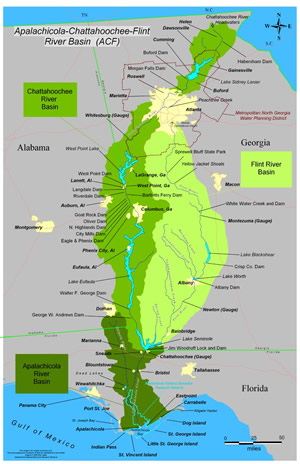By Georgia Ackerman
April 6, 2021–The recent U.S. Supreme Court decision regarding water of the Apalachicola-Chattahoochee-Flint Rivers felt like a legal gut punch. In dismissing the FL v. GA case, the justices offered no relief for the Apalachicola River and Bay. In writing for the court, Justice Amy Coney Barret stated, “In short, Florida has not met the exacting standard necessary to warrant the exercise of this Court’s extraordinary authority to control the conduct of a coequal sovereign. We emphasize that Georgia has an obligation to make reasonable use of Basin waters in order to help conserve that increasingly scarce resource. But in light of the record before us, we must overrule Florida’s exceptions to the Special Master’s Report and dismiss the case.”
Indeed, freshwater is an “increasingly scarce resource” to those downstream of the Woodruff Dam. River flow is the lifeblood of the swamps, streams, and estuary of the Apalachicola River and Bay ecosystem with livelihoods depending on it. Over 400 miles of creeks, lakes and sloughs are connected to the 107-mile Apalachicola River, moving freshwater and life-giving nutrients from the floodplain to the river and onto the Apalachicola Bay. The Apalachicola River is Florida’s largest river in volume of flow and its forested floodplain is the state’s largest. The Gulf of Mexico’s ecological health is supported by the Apalachicola River and Bay. It’s all connected from the Blue Ridge Mountains where the Chattahoochee River begins, to the Gulf of Mexico, the Apalachicola River’s southern terminus.
the floodplain to the river and onto the Apalachicola Bay. The Apalachicola River is Florida’s largest river in volume of flow and its forested floodplain is the state’s largest. The Gulf of Mexico’s ecological health is supported by the Apalachicola River and Bay. It’s all connected from the Blue Ridge Mountains where the Chattahoochee River begins, to the Gulf of Mexico, the Apalachicola River’s southern terminus.
Regrettably, upstream water management and flow regulation fail to address downstream realities. Shortsighted flow regulation policies by the U.S. Army Corps of Engineers (USACE), who control the 5 ACF federal dams, have encouraged upstream consumption by holding river water in reservoirs instead of releasing it to the Apalachicola River in a timely manner. Profound changes by the USACE to historic flow patterns have led to decreased flows in the late spring and summer of most years, devastating the vast wetland forests. Fish, invertebrates and plants are deprived of fresh water during the hot summer months when they need it most. The oyster harvest collapsed in 2012, the year with the lowest flow ever recorded. With increased salinity in the estuary, long-time commercial fisherman reported oyster predators never seen before in the Apalachicola Bay. Oyster populations remain in decline with the world-renowned Apalachicola Bay now closed to wild oyster harvesting for up to five years. Restoration efforts are underway by the Florida Fish and Wildlife Conservation Commission while, FSU’s Apalachicola Bay System Initiative simultaneously develops a holistic management plan for the bay.
 In April 2017, Apalachicola Riverkeeper, National Wildlife Federation, and Florida Wildlife Federation filed a lawsuit against the U.S. Army Corps of Engineers in federal court. Represented by Earthjustice, the lawsuit challenges the Corps’ decisions on how to manage water in the Apalachicola-Chattahoochee-Flint River basin. This includes withholding unprecedented levels of water upstream to the detriment of the ecosystems and downstream communities like ours. The suit asks the Court to order the U.S. Army Corps of Engineers to re-do the water management plan and environmental impact statement to comply with federal environmental laws. Another case by Alabama stakeholders challenging the Corps’ decisions was also filed against the USACE. These cases were combined and remain active in federal court. An outcome is anticipated by August 2021.
In April 2017, Apalachicola Riverkeeper, National Wildlife Federation, and Florida Wildlife Federation filed a lawsuit against the U.S. Army Corps of Engineers in federal court. Represented by Earthjustice, the lawsuit challenges the Corps’ decisions on how to manage water in the Apalachicola-Chattahoochee-Flint River basin. This includes withholding unprecedented levels of water upstream to the detriment of the ecosystems and downstream communities like ours. The suit asks the Court to order the U.S. Army Corps of Engineers to re-do the water management plan and environmental impact statement to comply with federal environmental laws. Another case by Alabama stakeholders challenging the Corps’ decisions was also filed against the USACE. These cases were combined and remain active in federal court. An outcome is anticipated by August 2021.
Apalachicola Riverkeeper remains committed to protection and restoration of the Apalachicola River, floodplain and bay. This includes our current legal challenge to the USACE in federal court, a multi-year slough restoration project, participation in the Apalachicola Bay System Initiative and the ACF Stakeholders collaboration. A Sustainable Water Management Plan for was developed by the ACF Stakeholders a few years back. We urge the state leaders of Alabama, Georgia and Florida to collaboratively review this water sharing plan.
Lastly, it’s important to remember the U.S. Congress oversees the U.S. Army Corps of Engineers. Changes in federal water policy can be set in motion by Congress. Who oversees Congress? That’s the job of the each of us, the citizens. Let your elected officials know that the Apalachicola River and Bay deserves long-term protection, and we need steadfast leadership across the
ACF region working on tangible solutions. We know people across the United States care about this remarkable river and bay system. Make the protection of Florida’s water a priority voting issue. While the FL v GA legal challenge ended in the U.S. Supreme Court recently, it does not conclude the work to be done in protecting and restoring the extraordinary Apalachicola River and Bay. We must all work steadfastly together to save this American treasure.

Georgia Ackerman is Riverkeeper and Executive Director at Apalachicola Riverkeeper, a member of Waterkeepers Florida and the international Waterkeeper Alliance.
A version of this blog was published in the Apalachicola Times on April 8, 2021 and in the Tallahassee Democrat on April 13.

